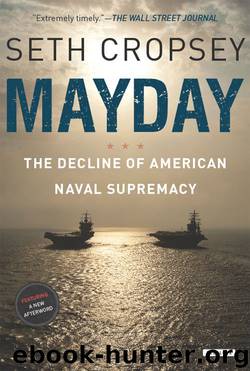Mayday by Seth Cropsey

Author:Seth Cropsey [CROPSEY, SETH]
Language: eng
Format: epub
Tags: HIS000000; HIS027000; HIS027150; HIS027110; HIS037080; HIS036070; POL011000; POL012000;
ISBN: 9781468310009
Publisher: The Overlook Press
Published: 2014-05-03T00:00:00+00:00
Persia’s western frontier at the beginning of the war reached the Mediterranean where it washes modern-day Turkey’s shores. Under its king, Darius, the first Persian invasion was turned back at the Battle of Marathon in 490. Darius’s son, Xerxes, led a second large invasion twelve years later. A large army crossed the Hellespont accompanied by an equally impressive naval force assembled to provide supplies, assist in moving troops, and maintain communications with the Persians’ land base in Asia. During this second major invasion the Spartan king Leonidas, commanding a small force of his own and allied units, held back the entire Persian army at a narrow coastal pass between steep mountains immediately to the south and the straits that separate the long island of Euboea from the Greek mainland. The Athenian-led naval coalition also suffered a defeat in the same straits of Artemisium. The Greek commanders’ intent to stop the Persian force before it could move south along the Aegean’s eastern coast toward the Peloponnese had failed. The Greek fleet retreated to the strait of Salamis near the end of the Attic Peninsula and by the stratagems and deceptions of its commander, Themistocles, succeeded in engaging the numerically far superior Persian fleet in the narrow waters of the strait where the Persian navy’s large size probably worked against it. The naval battle of Salamis demoralized the Persian force and was followed by Greek coalition victories at Plataea and Mycale, thus ending the Persian threat to Greece. Athens’s naval prowess was decisive in turning back the Persian invaders and the alliance known as the Delian League—named after Delos, the island on which the alliance was formalized —established itself to avoid a third Persian invasion and came eventually under Athenian control. The alliance was composed of coastal areas of the northern and eastern Aegean, the islands large and small that lie between Asia Minor and Greece, and a handful of polities on the east coast of the southern Adriatic Sea. As the original NATO alliance was composed of states that bordered the Atlantic or its adjoining waters, the Delian League was an association of city-states, islands, and littoral areas that bordered the sea or were set in it.
Almost within sight of the Aegean, Athens’s livelihood, commerce, and security rode on the sea. By the beginning of the Peloponnesian War in 431 BC, she was the Mediterranean’s great naval power. In the midst of a dispute between two Greek city-states, one that ultimately precipitated the Peloponnesian War, an emissary from the smaller power argued for alliance with Athens, noting that the combination of the two polities’ navies would strengthen both. “Yourselves excepted, we are the greatest naval power in Hellas.” 3 In fact, Athenian policy in this dispute—which turned violent—turned importantly on calculations of the consequences for Athens’s naval power. But initial Athenian strategy in the war against Sparta is the most persuasive testament to the breadth and reach of Athens’s naval power. The great Athenian statesman Pericles argued effectively at the beginning of the Peloponnesian War for a strategy of deterrence.
Download
This site does not store any files on its server. We only index and link to content provided by other sites. Please contact the content providers to delete copyright contents if any and email us, we'll remove relevant links or contents immediately.
| Africa | Americas |
| Arctic & Antarctica | Asia |
| Australia & Oceania | Europe |
| Middle East | Russia |
| United States | World |
| Ancient Civilizations | Military |
| Historical Study & Educational Resources |
Cecilia; Or, Memoirs of an Heiress — Volume 1 by Fanny Burney(32435)
Cecilia; Or, Memoirs of an Heiress — Volume 2 by Fanny Burney(31871)
Cecilia; Or, Memoirs of an Heiress — Volume 3 by Fanny Burney(31856)
The Secret History by Donna Tartt(18849)
Sapiens: A Brief History of Humankind by Yuval Noah Harari(14252)
Leonardo da Vinci by Walter Isaacson(13184)
The Radium Girls by Kate Moore(11921)
Sapiens by Yuval Noah Harari(5294)
How Democracies Die by Steven Levitsky & Daniel Ziblatt(5128)
The Wind in My Hair by Masih Alinejad(5034)
Homo Deus: A Brief History of Tomorrow by Yuval Noah Harari(4826)
Endurance: Shackleton's Incredible Voyage by Alfred Lansing(4676)
The Silk Roads by Peter Frankopan(4457)
Man's Search for Meaning by Viktor Frankl(4426)
Millionaire: The Philanderer, Gambler, and Duelist Who Invented Modern Finance by Janet Gleeson(4376)
The Rape of Nanking by Iris Chang(4138)
Joan of Arc by Mary Gordon(4014)
The Motorcycle Diaries by Ernesto Che Guevara(4012)
Hitler in Los Angeles by Steven J. Ross(3900)
